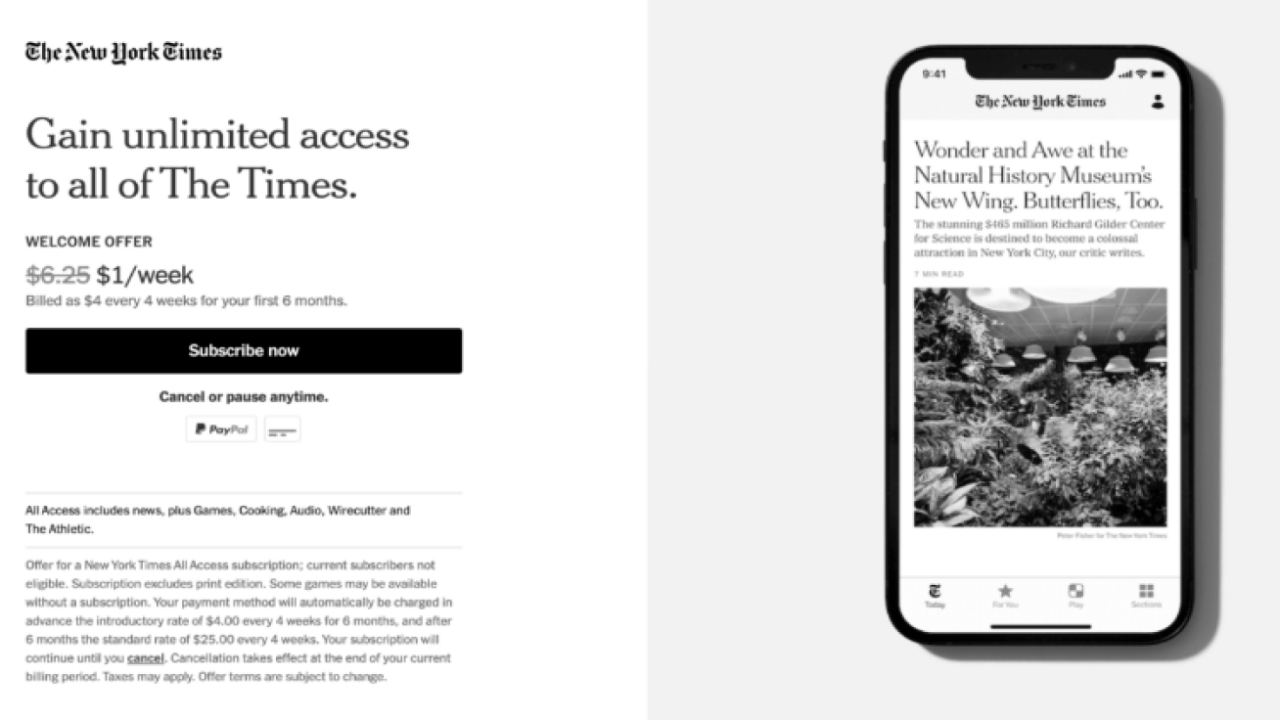When bundling makes sense for your business
05
06 Minute Read

Value meals. Home & auto insurance. Streaming services. The list goes on ...
We see bundling everywhere, but is it the right move for your subscription business?
Bundles address challenges companies face in selling individual products or features. By grouping offerings together, they can appeal to specific groups of customers. While some businesses see bundles as a strategic growth driver, others turn to them as an attempt to address declining conversion rates. Bundling can also be a way to introduce new features and gauge market interest.
The New York Times is a great example of how to offer a variety of products or services under one roof, with its news, sports, games, and other products — all offered as a bundle and individually. And it works for them: In the first quarter of 2024, The New York Times gained more than 200,000 digital subscribers, growing to a total of 10.5 million print and digital subscribers.
This approach can be a win-win for both brand and consumer, but is bundling the magic bullet for every subscription business, or are there hidden dangers lurking beneath the surface? While bundling offers convenience, cost savings, and the potential for customers to discover new offerings, it also raises concerns about overwhelming choice, hidden costs, and the potential for diminishing returns over time. In this chapter, we’ll help you decide whether bundling is the right strategy for your business.
The New York Times sells an All Access bundle as well as individual subscriptions for its news, sports, game, cooking, audio, and product review offerings.

The right way to bundle
The most common reasons businesses bundle are to increase cross-sell and value perception, protect against competitors, provide expertise and simplified choice, and offer a range of pricing options, according to global consulting firm Simon-Kutcher.
But successful bundling isn’t just about throwing a bunch of products together and hoping for the best.
“The first step is understanding your customers’ needs,” says David Warren, Principal Director at the Subscribed Institute. “You need to know each ideal customer profile, whether it’s defined by industry, segment, demographics, or psychographics. Find out what needs are common within each profile and then bundle accordingly.”
Next: pricing. You need to strike a delicate balance, ensuring that the bundled price doesn’t devalue the individual components.
Think of it like a carefully curated playlist or album: each song should complement the others, creating a cohesive and enjoyable experience. To achieve this with your bundles, you need to track the performance of each component. Are certain products driving conversions? Are others simply adding clutter? By analyzing this data, you can refine your bundles over time, ensuring that each element contributes to both your bottom line and your customers’ perceived value.
Flexibility is another key ingredient in the bundling recipe. Not everyone wants the same thing, and that’s okay. By being able to dynamically price bundles and standalone options based on the preference of the customer, you empower them to tailor their experience to their specific needs. It’s like a choose-your-own-adventure book, where the customer gets to decide which path to take. And just like a good author, you should be paying close attention to your readers’ choices. By monitoring customer usage data, you can gain valuable insights into how your bundled products are actually being used, revealing hidden opportunities for improvement.
Not sure how a new product will play? Another way to use a bundle is to introduce something new from your innovation roadmap.
“You may have a new innovation you haven’t tested enough,” Warren says. “You’re not sure about the pricing. You may not be sure people will understand what it is. So you bundle it just to get it in customers’ hands so you can learn. Maybe just give it to your most valuable customers as a reward for their loyalty and then go from there.”

Risks and challenges
While subscription bundling can be a powerful tool for growth, it’s important to be aware of potential risks. The first being bundling for the wrong reason.
“Sometimes bundles can become a form of desperation: ‘We need to grow, grow, grow. We’ll figure out profitability later, just convert as many customers as possible.’” Warren says. “We saw this in SaaS up until the last couple of years. Let’s just give away the house. Let’s give them everything at a really great price, and they’ll feel like ‘I’m getting an amazing deal,’ and we’ll figure out how to make money off of them later.”
Bundles don’t work if they’re just a money grab. They need to be informed by consumer demand and adjusted based on usage.
In that same vein, another risk is making a bundle the only option for customers, according to Vineet Kumar, associate professor of marketing at the Yale School of Management.
“If consumers really want a product and they only have the option of buying the bundle, you would think the company could potentially take in more revenue since the consumer has no choice but to get the bundle,” he explains to Forbes. “But it turns out that’s not the case.”
Why? According to Kumar, they might wait for a better deal to come along. Sometimes, the price of the bundle or the bundle itself can alienate customers. They either wait for the price to drop, or go to a competitor offering a better deal.
Remember when we said pricing is critical? When done the wrong way, your business could lose money. What do we mean by that? Well, many companies introduce bundles at a discounted rate. Eventually, that promotion ends, and consumers will have to pay more. A sizable share will not go for it especially if they didn’t use all aspects of the bundle during that initial period.
“When it comes time for renewal, the customer realizes, ‘You know, I’m not using 70% of what I got.’ They forgot about the great deal. ‘I want to take these seven things off, and I want a discount,’” Warren says. “Well, you’ve already discounted that bundle. And now the customer wants to downsell themselves even more to the point where you might actually be losing money on that customer, so you shouldn’t have bundled in the first place, because you gave them a bunch of stuff that they weren’t all that interested in in the first place. And now you’re actually not growing. Your ARPA [annual revenue per account] is going down.”
This happens because companies inadvertently devalue individual components when incorporating them into bundles, making it difficult to unbundle them later if consumption or market conditions change. This can also lead to pricing challenges, as adjustments to the bundled price may be necessary to reflect the removal or addition of components, potentially alienating existing customers.
“The biggest challenge with bundling is keeping track of the relative value each component contributes over time,” Warren says. “Do you understand how much of it is driving conversion? The risk is moving too quickly to unbundle and either underpricing or overpricing, based on a misunderstanding of its true worth.”
While bundling offers undeniable benefits, it’s crucial for businesses to carefully consider these potential drawbacks. A successful bundling strategy should focus on delivering genuine value to customers by combining products or services that complement each other and address specific needs, rather than simply adding more options for the sake of it.

Bundles: A powerful tool, but not a one-size-fits-all solution
Subscription bundles are a powerful tool for growth, but they should not be viewed as a standalone solution. Instead, they should be integrated into a broader monetization strategy that prioritizes the needs and preferences of customers. Businesses should offer a variety of pricing models — bundles, individual subscriptions, and add-ons — to cater to diverse customer segments. Analyzing customer data and usage patterns provides valuable insights into which products or services naturally complement each other, enabling the creation of bundles that deliver genuine value.
The key to successful bundling lies in striking the right balance. Bundles can attract new customers and increase revenue, but they must also meet the evolving needs and expectations of existing subscribers. This requires a deep understanding of how customers use a product, what features they value most, and how much they are willing to pay for different combinations of offerings. By leveraging data-driven insights, companies can continuously refine their bundling strategies and ensure that they are providing the most relevant and appealing options to their customers.
Bundles have firmly established their place in the subscription landscape. Their long-term success hinges on the ability of businesses to adapt and innovate, offering a mix of bundled and unbundled options that reflect the diverse needs and preferences of their customers. Companies that continuously experiment and refine their offerings to deliver the best possible customer experience will thrive in this environment.
Even with bundling, churn is inevitable. However, managing churn effectively through win-back strategies can make a significant difference to your retention efforts.

Previous Chapter
How AI-driven offers and experiences can transform publishing

Next Chapter

